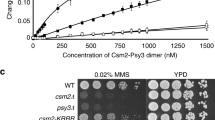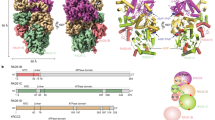Abstract
Heteroduplex joints represent intermediates of Rad51-dependent recombination processes, which are recognized by p53 with extremely high affinities, in a manner independent of the DNA sequence content. To determine the structural elements required for complex formation, we monitored DNA-binding by protection against restriction endonuclease cleavage. We show that wild-type (wt) p53 interacts with heteroduplex joints in the proximity of the flexible junction. Association of p53 within this junction region was also observed with preformed Rad51-heteroduplex complexes, whereas SSB counteracted p53 binding. At a distance of 31 bp from the junction p53 established very few contacts with the heteroduplex, despite the presence of an A–G mismatch. Consistently, p53-dependent exonucleolytic degradation decreased when we raised the distance between the junction and the heteroduplex terminus by 27 bp. Different from the cancer-related mutant p53(273H), which did not recognize the junction, tetramerization defective p53-1262 was protection competent but displayed reduced complex stability in gel shifts. Moreover, p53-1262 performed exonucleolytic activities towards ssDNA like wtp53, but reduced degradation of heteroduplex joints. These results suggest that during recombination wild-type p53, as a tetramer, stably binds to strand transfer regions, enabling the protein to exonucleolytically correct heteroduplex intermediates early after strand invasion.
This is a preview of subscription content, access via your institution
Access options
Subscribe to this journal
Receive 50 print issues and online access
$259.00 per year
only $5.18 per issue
Buy this article
- Purchase on Springer Link
- Instant access to full article PDF
Prices may be subject to local taxes which are calculated during checkout





Similar content being viewed by others
References
Ahrendt SA, Decker PA, Doffek K, Wang B, Xu L, Demeure MJ, Jen J, Sidransky D . 2000 Cancer Res. 60: 2488–2491
Albrechtsen N, Dornreiter I, Grosse F, Kim E, Wiesmüller L, Deppert W . 1999 Oncogene 8: 7706–7717
Atz J, Wagner P, Roemer K . 2000 J. Cell. Biochem. 76: 572–584
Bakhanashvili M . 2001 Eur. J. Biochem. 268: 2047–2054
Balagurumoorthy P, Sakamoto H, Lewis MS, Zambrano N, Clore GM, Gronenborn AM, Appella E, Harrington RE . 1995 Proc. Natl. Acad. Sci. USA 92: 8591–8595
Baumann P, West SC . 1998 Trends Biochem. Sci. 23: 247–251
Bertrand P, Rouillard D, Boulet A, Levalois C, Soussi T, Lopez BS . 1997 Oncogene 14: 1117–1122
Blander G, Kipnis J, Fernando J, Leal JFM, Yu C-E, Schellenberg GD, Oren M . 1999 J. Biol. Chem. 274: 29463–29469
Chene P, Bechter E . 1999a J. Mol. Biol. 288: 891–897
Chene P, Bechter E . 1999b J. Mol. Biol. 286: 1269–1274
Cleaver E, Afzal V, Feeney L, McDowell M, Sadinski W, Volpe JP, Busch DB, Coleman DM, Ziffer DW, Yu Y, Nagasawa H, Little JB . 1999 Cancer Res. 59: 1102–1108
Cho Y, Gorina S, Jeffrey PD, Pavletich NP . 1994 Science 265: 346–355
Constantinou A, Tarsounas M, Karow JK, Brosh RM, Bohr VA, Hickson ID, West SC . 2000 EMBO Rep. 1: 80–84
Dasika GK, Lin S-C, Zhao S, Sung P, Tomkinson A, Lee EY-H . 1999 Oncogene 18: 7883–7899
Dudenhöffer C, Rohaly G, Will K, Deppert W, Wiesmüller L . 1998 Mol. Cell. Biol. 18: 5332–5342
Dudenhöffer C, Kurth M, Janus F, Deppert W, Wiesmüller L . 1999 Oncogene 18: 5773–5784
Flores-Rozas H, Kolodner RD . 2000 Trends Biochem. Sci. 25: 196–200
Gebow D, Miselis N, Liber HJ . 2000 Mol. Cell. Biol. 20: 4028–4035
Haber J . 1999 Trends Biol. Sci. 24: 271–275
Honma M, Hayashi M, Sofuni T . 1997 Mutat. Res. 374: 89–98
Huang P . 1998 Oncogene 17: 261–270
Ishizaki K, Ejima Y, Matsunaga T, Hara R, Sakamoto A, Ikenaga M, Ikawa Y, Aizawa S . 1994 Int. J. Cancer 58: 254–257
Janus F, Albrechtsen N, Knippschild U, Wiesmüller L, Grosse F, Deppert W . 1999 Mol. Cell. Biol. 19: 2155–2168
Jayaraman L, Prives C . 1995 Cell 81: 1021–1029
Jean D, Gendron D, Delbecchi L, Bourgaux P . 1997 Nucl. Acids Res. 25: 4004–4012
Kühn C, Müller F, Melle C, Nasheuer HP, Janus F, Deppert W, Grosse F . 1998 Oncogene 18: 769–774
Lane DP . 1992 Nature 358: 15–16
Lee S, Elenbaas B, Levine A, Griffith J . 1995 Cell 81: 1013–1020
Lee S, Elenbaas B, Levine AJ, Griffith J . 1997 J. Biol. Chem. 272: 7532–7539
Levine A . 1997 Cell 88: 323–331
Mekeel KL, Tang W, Kachnic LA, Luo C-M, DeFrank JS, Powell SN . 1997 Oncogene 14: 1847–1857
Meyn MS, Strasfeld L, Allen C . 1994 Int. J. Radiat. Biol. 66: S141–S149
Mummenbrauer T, Janus F, Müller B, Wiesmüller L, Deppert W, Große F . 1996 Cell 85: 1089–1099
Nagaich AK, Zhurkin VB, Durell SR, Jernigan RL, Appella E, Harrington RE . 1999 Proc. Natl. Acad. Sci. USA 96: 1875–1880
Nagaich AK, Zhurkin VB, Sakamoto H, Gorin AA, Clore GM, Gronenborn AM, Appella E, Harrington RE . 1997a J. Biol. Chem. 272: 14830–14841
Nagaich AK, Appella E, Harrington RE . 1997b J. Biol. Chem. 272: 14842–14849
Palecek E, Vlk D, Stankova V, Brazda V, Vojtesek B, Hupp TR, Schaper A, Jovin TM . 1997 Oncogene 15: 2201–2209
Pham P, Bertram JG, O'Donnell M, Woodgate R, Goodman M . 2001 Nature 409: 366–370
Saintigny Y, Rouillard D, Chaput B, Soussi T, Lopez BS . 1999 Oncogene 18: 3553–3565
Schwartz JL, Russell KJ . 1999 Radiat. Res. 151: 385–390
Shakked Z, Yavnilovitch M, Gilboa AJ, Rotter V, Haran TE . 2000 J. Biomol. Struct. Dyn. Mendal Brno 2000 abstract
Skalski V, Lin Z-Y, Choi BY, Brown KR . 2000 Oncogene 19: 3321–3329
Stenger JE, Tegtmeyer P, Mayr G, Reed M, Wang Y, Wang P, Hough PV, Mastrangelo IA . 1994 EMBO J. 13: 6011–6020
Süsse S, Janz C, Janus F, Deppert W, Wiesmüller L . 2000 Oncogene 19: 4500–4512
Tarunina M, Grimaldi M, Ruaro E, Pavlenko M, Schneider C, Jenkins JR . 1996 Oncogene 13: 589–598
Tokino T, Thiagalingam S, El-Deiry WS, Waldman T, Kinzler KW, Vogelstein B . 1994 Hum. Mol. Genet. 3: 1537–1542
Wiesmüller L, Cammenga J, Deppert WW . 1996 J. Virol. 70: 737–744
Willers H, McCarthy EE, Wu B, Wunsch H, Tang W, Taghian DG, Xia F, Powell SN . 2000 Oncogene 19: 632–639
Wold MS . 1997 Annu. Rev. Biochem. 66: 61–92
Xia F, Amundson SA, Nickoloff JA, Liber HL . 1994 Mol. Cell. Biol. 14: 5850–5857
Zotchev SB, Protopopova M, Selivanova G . 2000 Nucleic Acids Res. 28: 4005–4012
Acknowledgements
Our special thanks go to Prof Dr John Jenkins, Marie Curie Research Institute, Oxted, Surrey, UK, for the generous gift of the baculoviral expression plasmid for p53-1262. We are grateful to Anke Osterloh and Marco Littek for competent experimental assistance. This work was supported by the Deutsche Forschungsgemeinschaft, grants Wi 1376/1-4 and -5 and grant 10-1281-Wi I by the Deutsche Krebshilfe, the Dr Mildred Scheel Stiftung. S. Süsse was supported by the FAZIT-Stiftung, Frankfurt a.M.
Author information
Authors and Affiliations
Corresponding author
Rights and permissions
About this article
Cite this article
Janz, C., Süsse, S. & Wiesmüller, L. p53 and recombination intermediates: role of tetramerization at DNA junctions in complex formation and exonucleolytic degradation. Oncogene 21, 2130–2140 (2002). https://doi.org/10.1038/sj.onc.1205292
Received:
Revised:
Accepted:
Published:
Issue Date:
DOI: https://doi.org/10.1038/sj.onc.1205292
Keywords
This article is cited by
-
Chromosome instability and deregulated proliferation: an unavoidable duo
Cellular and Molecular Life Sciences (2012)
-
Relationship between VEGF and p53 expression and tumor cell proliferation in human gastrointestinal carcinomas
Journal of Cancer Research and Clinical Oncology (2007)
-
p53 in recombination and repair
Cell Death & Differentiation (2006)
-
p53: traffic cop at the crossroads of DNA repair and recombination
Nature Reviews Molecular Cell Biology (2005)
-
Wild-type p53 stimulates homologous recombination upon sequence-specific binding to the ribosomal gene cluster repeat
Oncogene (2005)



